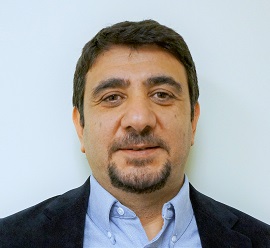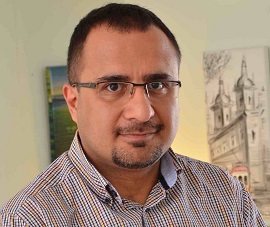Drexel University, United States
Wright State University, United States
Middle East Technical University, Turkey
To introduce four common sensors including functional magnetic resonance imaging (fMRI), electroencephalography (EEG), eye tracker, and functional near infrared spectroscopy (fNIRS) and discuss "Which Measurement Technique to Implement, What to Measure, and How to Analyze"
Recent years have seen a marked increase in the availability of sensor technologies for measuring and assessing multiple aspects of cognition. Many of these aspects are crucial in many professional domains, key example of which is the aviation and aerospace domains. No discussion of the psychology and human factors of aviation, for instance, will be complete without cognitive constructs such as attention and workload as well as their relation to human performance in safety critical environments. But, how exactly can ongoing neural activity or any other trackable biosensor data be related to these cognitive factors? The neuroergonomics approach, introduced by Parasuraman (2008) establishes a connecting link between neurophysiological measurements to their underlying cognitive factors and thus paved the way for widespread use of wearable physiological monitoring sensors and real-time analytic techniques for objective assessment of human operators’ cognitive and physical states (Parasuraman & Rizzo, 2008). In this workshop we will introduce and discuss the neuroergonomics approach using aviation as an example of a domain which has greatly benefited from the application of the neuroergonomic approach. Sensor technologies are now everywhere, providing both researchers and end users unprecedented means to assess operator neurophysiological, cognitive and physical states. Moreover, this trend also provides end-users with an opportunity to apply such technologies in more contextually real and dynamic environments. Hence, this workshop will focus on know-how exchange and discussion on the most common and most frequently used for monitoring brain function, including fMRI, EEG, eye tracking, and fNIRS. The speakers will share their in-depth knowledge and experience, discuss on pros and cons of these select techniques, as well as their potential implementation in aviation, and information processing and analysis.
Benefits:
Researchers, subject matter experts from the field of aviation, and attendees who are interested in cognitive neuroscience and neurophysiology monitoring techniques. This tutorial will be beneficial to not only audience from aviation domain but also other professional domains such as the medicine, health care, defense or any person working in the area of cognitive neuroscience and planning to implement different modalities for objective and reliable assessment of human performance and training in safety critical environments.

Dr. Kurtulus Izzetoglu is a biomedical engineer, and a faculty of Drexel University, Philadelphia, USA. Dr. Izzetoglu’s research and teaching interests are in neuroimaging, functional near-infrared spectroscopy (fNIRS), human performance, learning, training, medical sensor development, biomedical systems and signal processing. He has background in both electrical and biomedical engineering coupled with experience of developing a highly portable fNIRS system for use in field applications and translational neuroimaging.
Over the last decade, he has been focusing on development of performance and training assessment biosensors and metrics for joint human-system performance enhancement. Some of his current research projects include cognitive workload assessment of air traffic controllers, pilots and unmanned aircraft pilots and operators; role of neurotechnology to improve pilot and medical personnel training. He has been institutional principal investigator and the university lead for the FAA Center of Excellence for Technical Training and Human Performance (TTHP), and for the FAA Center of Excellence for Unmanned Aircraft Systems (UAS). He serves on the boards and program committees, including International Conference on Augmented Cognition; International Conference for Research in in Air Transportation; and International Symposium on Aviation Psychology. He also organized and chaired annual meeting of the center of excellence for Technical Training & Human Performance in 2018.

Dr. Assaf Harel is a cognitive neuroscientist heading the Human Neuroscience and Visual Cognition Lab at the Department of Psychology at Wright State University. With twenty years of research experience, he is particularly interested in how visual recognition occurs in real-world settings and his research adopts a neuroergonomic approach to study the applied aspects of high-level vision. His research interests include visual expertise, scene imagery analysis, training, perceptual categorization, top-down attention, and cognitive control.
Research in the Human Neuroscience and Visual Cognition Lab combines a host of cognitive neuroscience techniques, including EEG, fMRI, psychophysics, and eye tracking to study how people perceive and think about the world around them, and how these processes are substantiated in the brain. The goal of the Human Neuroscience and Visual Cognition Lab is to promote a highly interdisciplinary research that will bridge diverse theoretical, experimental and applied approaches to uncover how brain activity gives rise to high-level vision in the real world.
Dr. Harel received his PhD in Cognitive Neuropsychology at the Hebrew University of Jerusalem (Israel), studying expertise in visual object recognition. His research demonstrated that visual experience manifests as a top-down process, which recruits a host of higher-level cognitive functions (cognitive control, memory, conceptual knowledge) supported by distributed cortical networks. Dr. Harel was a visiting fellow at the Laboratory of Brain and Cognition at the National Institute of Mental Health in National institutes of Health (NIMH/NIH), where he performed cutting-edge fMRI research using multivariate analytical methods.

Dr. Cengiz Acarturk is a cognitive scientist and a faculty member of the Cognitive Science Graduate Program, Informatics Institute, Middle East Technical University, Turkey. Dr. Acarturk's research interests include eye tracking applications, group eye tracking, eye movements in reading, cybercognition and human factors in cybersecurity. He is a leading research in the HUMATE Human Meachine Teaming Lab, which conducts research on multimodal integration of sensor data for cognitive state assessment. His research on eye tracking covers the investigation of oculomotor control in adult reading and dyslexic reading, as well as the use of eye tracking in clinical research, in the real world, as well as in virtual environments. He teaches graduate courses on visual cognition, reading, and cyber systems.